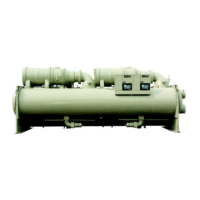Product Manual PM WSC/WDC 59
Thermal Storage
McQuay chillers are designed for use in thermal storage systems. The chillers have two operating conditions
that must be considered. The first is normal air conditioning duty where leaving evaporator fluid temperatures
range from 40°F to 45°F (4.4°C to 7.2°C). The second condition occurs during the ice making process when
leaving fluid temperatures are in the 22°F to 26°F (-5.6°C to -3.3°C) range.
The MicroTech control system will accommodate both operating points. The ice mode can be started or
stopped by a digital input signal to the microprocessor, through an Open Protocol Module (OPM) panel or
through a chilled water reset signal. When a signal is received to change from the ice mode to the normal
operating mode, the chiller will shut down until the system fluid temperature rises to the higher setpoint. The
chiller will then restart and continue operation at the higher leaving fluid temperature. When changing from
normal cooling to the ice mode, the chiller will load to maximum capacity until the lower set point is reached.
Computer selections must be made to insure that the chiller will operate at both conditions. If the “ice mode” is
at night, the pressure differentials between the evaporator and condenser are usually similar to normal cooling
applications. The leaving fluid temperature is lower, but the condensing temperature is also lower because the
cooling tower water is colder. If the ice mode can also operate during the day when cooling tower water
temperatures are high, a proper selection becomes more difficult because the two refrigerant pressure
differentials are significantly different.
A three-way condenser water control valve is always required.
Variable Speed Pumping
Variable speed pumping involves changing system water flow relative to cooling load changes. McQuay
centrifugal chillers are designed for this duty with two limitations. First, the rate of change in the water flow
needs to be slow, not greater than 2% per minute. The chiller needs time to sense a load change and respond.
Second, the water velocity in the vessels must remain between 3 and 10 fps (0.91 and 3.0 m/sec). Below 3 fps
(0.91 m/sec), laminar flow occurs which reduces heat transfer. Above 10 fps (3.0 m/sec), excessively high
pressure drops and tube erosion occur. These flow limits can be determined from the McQuay MS-85 selection
program.
We recommend variable flow only in the evaporator because there is virtually no change in chiller efficiency
compared to constant flow. Although variable speed pumping can be done in the condenser loop, it is usually
unwise. The intent of variable flow is to reduce pump horsepower. However, reducing condenser water flow
increases the chiller’s condensing pressure, increasing the lift that the compressor must overcome which, in
turn, increases energy use. Consequently, pump energy savings can be lost because the chiller operating
power is significantly increased.
Variable Frequency Drives
(Versus Dual Compressor Units)
Variable frequency drives improve chiller part load performance by varying the compressor speed from 100% to
approximately 70%. Most of the energy savings results from the reduced condenser water temperatures that
prevail at part load. At all load points, there are additional drive losses which increase the system energy use.
The initial cost for VFD is high.
WDC dual compressor chillers should be considered instead. They offer comparable part load performance and
have the “two chillers in one” benefit of system redundancy. System reliability is greatly enhanced by having
the two compressors for redundancy (parallel equipment-one fails the other runs) rather than the dependent
VFD (series equipment-one fails, neither runs).

